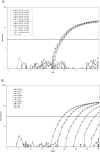Use of the espZ gene encoded in the locus of enterocyte effacement for molecular typing of shiga toxin-producing Escherichia coli
- PMID: 16455898
- PMCID: PMC1392676
- DOI: 10.1128/JCM.44.2.449-458.2006
Use of the espZ gene encoded in the locus of enterocyte effacement for molecular typing of shiga toxin-producing Escherichia coli
Abstract
Infections with Shiga toxin-producing Escherichia coli (STEC) result in frequent cases of sporadic and outbreak-associated enteric bacterial disease in humans. Classification of STEC is by stx genotype (encoding the Shiga toxins), O and H antigen serotype, and seropathotype (subgroupings based upon the clinical relevance and virulence-related genotypes of individual serotypes). The espZ gene is encoded in the locus of enterocyte effacement (LEE) pathogenicity island responsible for the attaching and effacing (A/E) lesions caused by various E. coli pathogens (but not limited to STEC), and this individual gene ( approximately 300 bp) has previously been identified as hypervariable among these A/E pathogens. Sequence analysis of the espZ locus encoded by additional STEC serotypes and strains (including O26:H11, O121:H19, O111:NM, O145:NM, O165:H25, O121:NM, O157:NM, O157:H7, and O5:NM) indicated that distinct sequence variants exist which correlate to subgroups among these serotypes. Allelic discrimination at the espZ locus was achieved using Light Upon eXtension real-time PCR and by liquid microsphere suspension arrays. The allele subtype of espZ did not correlate with STEC seropathotype classification; however, a correlation with the allele type of the LEE-encoded intimin (eae) gene was supported, and these sequence variations were conserved among individual serotypes. The study focused on the characterization of three clinically significant seropathotypes of LEE-positive STEC, and we have used the observed genetic variation at a pathogen-specific locus for detection and subtyping of STEC.
Figures




Similar articles
-
Sequence-based typing of genetic targets encoded outside of the O-antigen gene cluster is indicative of Shiga toxin-producing Escherichia coli serogroup lineages.J Med Microbiol. 2007 May;56(Pt 5):620-628. doi: 10.1099/jmm.0.47053-0. J Med Microbiol. 2007. PMID: 17446284 Free PMC article.
-
Serotypes, virulence genes, and intimin types of Shiga toxin (verotoxin)-producing Escherichia coli isolates from cattle in Spain and identification of a new intimin variant gene (eae-xi).J Clin Microbiol. 2004 Feb;42(2):645-51. doi: 10.1128/JCM.42.2.645-651.2004. J Clin Microbiol. 2004. PMID: 14766831 Free PMC article.
-
Serotypes, virulence genes, and intimin types of Shiga toxin (verotoxin)-producing Escherichia coli isolates from healthy sheep in Spain.J Clin Microbiol. 2003 Apr;41(4):1351-6. doi: 10.1128/JCM.41.4.1351-1356.2003. J Clin Microbiol. 2003. PMID: 12682113 Free PMC article.
-
Toxins of Locus of Enterocyte Effacement-Negative Shiga Toxin-Producing Escherichia coli.Toxins (Basel). 2018 Jun 14;10(6):241. doi: 10.3390/toxins10060241. Toxins (Basel). 2018. PMID: 29903982 Free PMC article. Review.
-
The locus of enterocyte effacement pathogenicity island of Shiga toxin-producing Escherichia coli O157:H7 and other attaching and effacing E. coli.Jpn J Med Sci Biol. 1998;51 Suppl:S101-7. doi: 10.7883/yoken1952.51.supplement1_s101. Jpn J Med Sci Biol. 1998. PMID: 10211442 Review. No abstract available.
Cited by
-
Multiplex detection of bacteria associated with normal microbiota and with bacterial vaginosis in vaginal swabs by use of oligonucleotide-coupled fluorescent microspheres.J Clin Microbiol. 2009 Dec;47(12):4067-77. doi: 10.1128/JCM.00112-09. Epub 2009 Sep 30. J Clin Microbiol. 2009. PMID: 19794034 Free PMC article.
-
The enteropathogenic Escherichia coli-secreted protein EspZ inhibits host cell apoptosis.Infect Immun. 2012 Nov;80(11):3850-7. doi: 10.1128/IAI.00335-12. Epub 2012 Aug 20. Infect Immun. 2012. PMID: 22907816 Free PMC article.
-
Isolation and genetic characterization of a coinfection of non-O157 Shiga toxin-producing Escherichia coli.J Clin Microbiol. 2007 Nov;45(11):3771-3. doi: 10.1128/JCM.01125-07. Epub 2007 Sep 5. J Clin Microbiol. 2007. PMID: 17804662 Free PMC article.
-
Genetic determinants and polymorphisms specific for human-adapted serovars of Salmonella enterica that cause enteric fever.J Clin Microbiol. 2006 Jun;44(6):2007-18. doi: 10.1128/JCM.02630-05. J Clin Microbiol. 2006. PMID: 16757591 Free PMC article.
-
Comparison of Shiga toxin-producing Escherichia coli detection methods using clinical stool samples.J Mol Diagn. 2010 Jul;12(4):469-75. doi: 10.2353/jmoldx.2010.090221. Epub 2010 May 13. J Mol Diagn. 2010. PMID: 20466837 Free PMC article.
References
-
- Blanco, J. E., M. Blanco, M. P. Alonso, A. Mora, G. Dahbi, M. A. Coira, and J. Blanco. 2004. Serotypes, virulence genes, and intimin types of Shiga toxin (verotoxin)-producing Escherichia coli isolates from human patients: prevalence in Lugo, Spain, from 1992 through 1999. J. Clin. Microbiol. 42:311-319. - PMC - PubMed
-
- Cherla, R. P., S. Y. Lee, and V. L. Tesh. 2003. Shiga toxins and apoptosis. FEMS Microbiol. Lett. 228:159-166. - PubMed
Publication types
MeSH terms
Substances
Associated data
- Actions
- Actions
- Actions
- Actions
- Actions
- Actions
- Actions
- Actions
- Actions
- Actions
- Actions
- Actions
- Actions
LinkOut - more resources
Full Text Sources
Other Literature Sources

